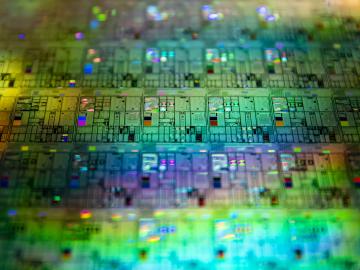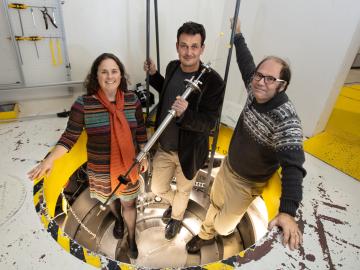
Filter News
Area of Research
- (-) Isotope Development and Production (1)
- (-) Neutron Science (36)
- (-) Supercomputing (83)
- Advanced Manufacturing (22)
- Biology and Environment (22)
- Building Technologies (1)
- Computer Science (6)
- Electricity and Smart Grid (3)
- Energy Science (145)
- Functional Materials for Energy (1)
- Fusion and Fission (11)
- Fusion Energy (3)
- Isotopes (4)
- Materials (116)
- Materials Characterization (1)
- Materials for Computing (17)
- Materials Under Extremes (1)
- National Security (26)
- Nuclear Science and Technology (11)
- Quantum information Science (9)
- Sensors and Controls (1)
- Transportation Systems (1)
News Topics
- (-) 3-D Printing/Advanced Manufacturing (10)
- (-) Critical Materials (3)
- (-) Cybersecurity (9)
- (-) Frontier (33)
- (-) Grid (5)
- (-) Materials Science (34)
- (-) Polymers (3)
- (-) Quantum Science (30)
- (-) Space Exploration (6)
- Advanced Reactors (2)
- Artificial Intelligence (40)
- Big Data (23)
- Bioenergy (14)
- Biology (16)
- Biomedical (28)
- Biotechnology (2)
- Buildings (4)
- Chemical Sciences (7)
- Clean Water (2)
- Composites (1)
- Computer Science (99)
- Coronavirus (19)
- Energy Storage (14)
- Environment (29)
- Exascale Computing (26)
- Fossil Energy (1)
- Fusion (2)
- High-Performance Computing (44)
- Hydropower (1)
- Irradiation (1)
- Isotopes (2)
- Machine Learning (17)
- Materials (28)
- Mathematics (2)
- Microscopy (8)
- Molten Salt (1)
- Nanotechnology (19)
- National Security (8)
- Neutron Science (122)
- Nuclear Energy (8)
- Partnerships (1)
- Physics (17)
- Quantum Computing (20)
- Security (7)
- Simulation (16)
- Software (1)
- Summit (43)
- Transportation (10)
Media Contacts

The prospect of simulating a fusion plasma is a step closer to reality thanks to a new computational tool developed by scientists in fusion physics, computer science and mathematics at ORNL.

An international team of researchers has discovered the hydrogen atoms in a metal hydride material are much more tightly spaced than had been predicted for decades — a feature that could possibly facilitate superconductivity at or near room temperature and pressure.

A team from the ORNL has conducted a series of experiments to gain a better understanding of quantum mechanics and pursue advances in quantum networking and quantum computing, which could lead to practical applications in cybersecurity and other areas.

Scientists at have experimentally demonstrated a novel cryogenic, or low temperature, memory cell circuit design based on coupled arrays of Josephson junctions, a technology that may be faster and more energy efficient than existing memory devices.

Gina Tourassi has been appointed as director of the National Center for Computational Sciences, a division of the Computing and Computational Sciences Directorate at Oak Ridge National Laboratory.

Scientists at the U.S. Department of Energy’s Brookhaven National Laboratory have new experimental evidence and a predictive theory that solves a long-standing materials science mystery: why certain crystalline materials shrink when heated.

Researchers at the Department of Energy’s Oak Ridge National Laboratory have received five 2019 R&D 100 Awards, increasing the lab’s total to 221 since the award’s inception in 1963.

A joint research team from Google Inc., NASA Ames Research Center, and the Department of Energy’s Oak Ridge National Laboratory has demonstrated that a quantum computer can outperform a classical computer

The type of vehicle that will carry people to the Red Planet is shaping up to be “like a two-story house you’re trying to land on another planet.

Using the Titan supercomputer at Oak Ridge National Laboratory, a team of astrophysicists created a set of galactic wind simulations of the highest resolution ever performed. The simulations will allow researchers to gather and interpret more accurate, detailed data that elucidates how galactic winds affect the formation and evolution of galaxies.


